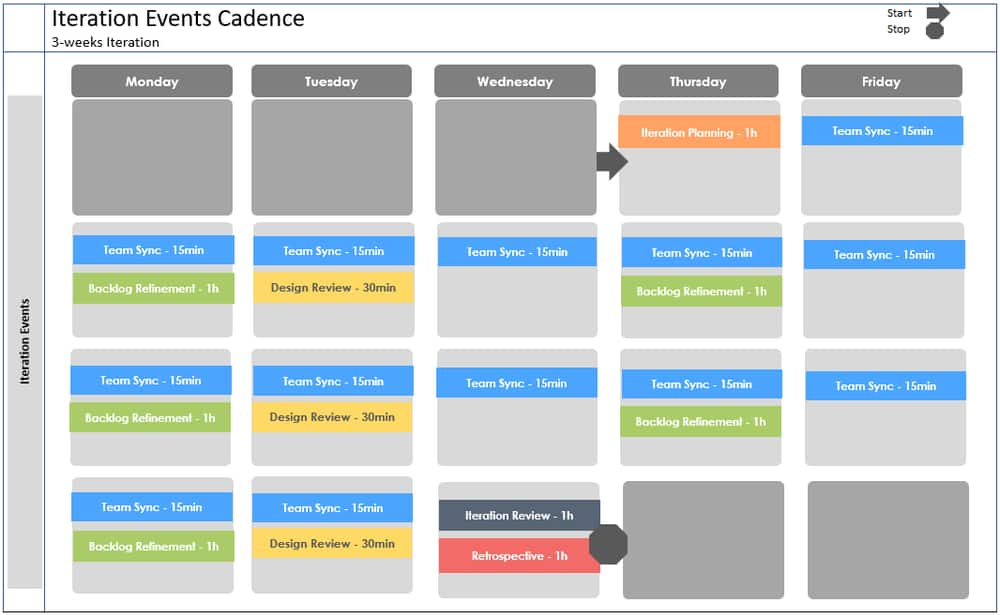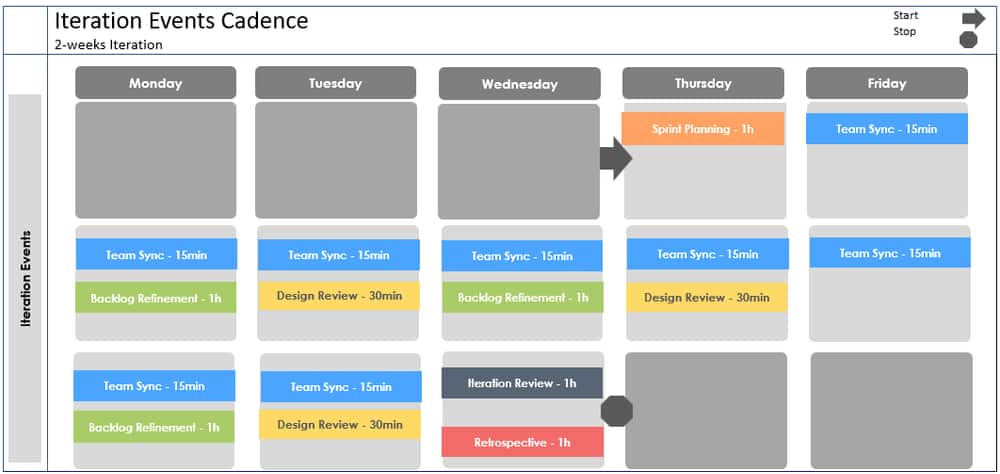| Events |
What |
Partcipants |
Frequency |
Duration |
Activities/Outcomes |
|---|
Iter ation Planning
|
First activity in each Iteration for all scrum teams
Teams select items from their backlog, review, estimate in more detail, and commit them to the
current Iteration for execution
|
|
Beginning of each iteration |
1 hours |
Review the available team capacity
Product owner and BA reviews the refined and prioritized stories with the team
Team members select high priority backlog items based on team capacity
Team members ask questions about user stories, and offer solutions, to increase estimation accuracy and encourage ongoing collaborative problem solving
Define and review the definition of “done” if needed
Revise user story points estimate, if necessary
Team members identify tasks for all the user stories such as coding tasks, testing tasks, documentation, etc…(can be done during refinement as well)
Team members finalize Iteration backlog and start the Iteration
Pro Tip:
Avoid any changes to scope post Iteration start however it can be done on on case basis. Any change to the Iteration backlog should be discussed/agreed with the team and necessary trade off should be done. SM to facilitate the conversation.
By default Dev lead capacity not part of Iteration capacity. Dev lead can pick up some stories (spike,analysis etc.) based on the need
|
| Team Sync |
|
|
Every day |
15 mins |
Pro Tip:
|
| Backlog Refinement |
Twice Weekly (minimum) review of the team backlog
PO presents new or existing unrefined stories for review. Team works together to refine
PO/BSA to ensure it meets Definition of Ready and can be planned in an upcoming Iteration
|
|
Weekly Twice |
1 hours |
The goal of Product Backlog refinement is to work with the Agile Team and stakeholders (when relevant), to get Product Backlog items in a ‘ready state’.
Removing user stories that no longer appear relevant
Creating new user stories in response to newly discovered needs
Re-assessing the relative priority of stories
Assigning estimates to stories which have yet to receive one
Correcting estimates in light of newly discovered information
Splitting user stories which are high priority but too coarse grained to fit in an upcoming iteration
|
| Iteration Review |
|
|
End of the iteration |
1 hour |
Pro Tip:
Ensure all required stakeholders are present in the meeting
No demo from developer machine
Document feedback and log in Jira
|
| Iteration Retrospective |
Occur at the end of Iteration after the Iteration Review for
all scrum teams
Team uncovers what worked well and what didn’t
creates action steps for improvement to try next Iteration
|
|
End of the iteration |
1 hour |
What went well?
What didn’t go well?
What can be done to improve performance/remove obstacles?
Identify changes to implement, improve and monitor in next Iteration (3 important ones)
Scrum team health check
Celebrate success
Pro Tip:
|
| Design Review |
Review the designs with PO
Gather feedback
|
Facilitator- Product owner
Participant- Team Coach, UI/UX designer, UI/UX lead and business stakeholder
|
Weekly |
0.5 hour
|
Applicable for Squads with scope of delivering value which involves UI/UX updates
Review the design with Product Owners to ensure the design aligns with the product vision, user needs, and technical constraints
Make a list of prioritized feedback
Identify potential issues & improvements
Pro Tip:
The designs created in the current iteration should be for N+1 iteration
|






